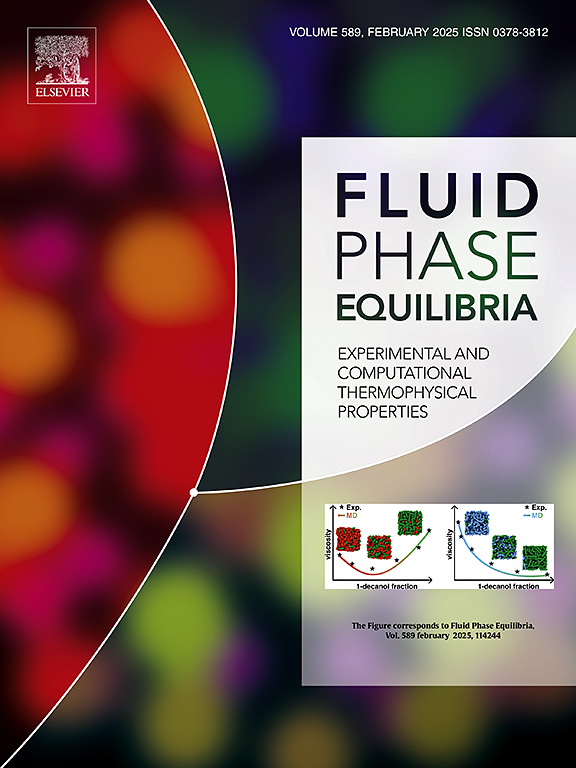Thermodynamic properties of some aqueous ionic liquid solutions using ion-SAFT-VR EOS
IF 2.7
3区 工程技术
Q3 CHEMISTRY, PHYSICAL
引用次数: 0
Abstract
The statistical association fluid theory (SAFT) approach for attractive potentials of variable range combined with interionic interactions, to describe some aqueous solutions of imidazolium ionic liquids (ILs) with different anion structures. The anions analyzed encompass [SCN]-, [DCA]–, [BF4]-, [NTF2]- and [PF6]- which show the effect of systematically change of the substituents on the anion. The proposed equation of state is a combination of a square-well variable range and a mean spherical approximation (MSA) corresponding to the restrictive primitive model to describe the long-range interactions of ILs. Water is characterized as a bipolar associating liquid combining the four-site model and a square-well potential with a constant dielectric continuum. The accurate predictions of volumetric properties for pure ILs and of water as well as the thermodynamic properties of binary aqueous IL solutions are significant evidence of the capability and excellent performance of the ion-SAFT-VR model. Parameters of the new version of the model have been reported and the model tested for an impressively large number of data sets. For binary mixtures of ILs and water, binary interaction coefficients were obtained by fitting experimental data at constant pressure and phase concentrations. The results show the satisfactory predictability of the ion-SAFT-VR EOS in modeling the thermodynamic properties of bulk systems, which indicates the reliability of the employed EOS. Due to the excellent results obtained for pure IL densities and the satisfactory results observed for aqueous solution of ILs, we can confidently conclude that the approach provides an overall commendable description of most IL systems.
离子液体水溶液热力学性质的离子- saft - vr EOS研究
结合离子间相互作用,用统计关联流体理论(SAFT)方法描述了具有不同阴离子结构的咪唑类离子液体(ILs)水溶液。所分析的阴离子包括[SCN]-、[DCA] -、[BF4]-、[NTF2]-和[PF6]-,表明取代基的系统变化对阴离子的影响。所提出的状态方程是一个相对应于约束原始模型的平方井变量范围和平均球面近似(MSA)的组合,用于描述离子间的远程相互作用。水的特征是一种双极性缔合液体,结合了四点模型和具有恒定介电连续体的方阱电位。离子- saft - vr模型准确预测了纯IL和水的p / t的体积性质以及二元IL水溶液的热力学性质,证明了离子- saft - vr模型的能力和优异的性能。报告了新版本模型的参数,并对模型进行了令人印象深刻的大量数据集测试。在恒压、恒相浓度条件下,通过拟合实验数据,得到了双相作用系数。结果表明,离子- saft - vr EOS在模拟体系统热力学性质方面具有令人满意的可预测性,表明所采用的EOS是可靠的。由于纯IL密度获得了极好的结果,并且在IL水溶液中观察到令人满意的结果,我们可以自信地得出结论,该方法提供了大多数IL系统的总体值得赞扬的描述。
本文章由计算机程序翻译,如有差异,请以英文原文为准。
求助全文
约1分钟内获得全文
求助全文
来源期刊

Fluid Phase Equilibria
工程技术-工程:化工
CiteScore
5.30
自引率
15.40%
发文量
223
审稿时长
53 days
期刊介绍:
Fluid Phase Equilibria publishes high-quality papers dealing with experimental, theoretical, and applied research related to equilibrium and transport properties of fluids, solids, and interfaces. Subjects of interest include physical/phase and chemical equilibria; equilibrium and nonequilibrium thermophysical properties; fundamental thermodynamic relations; and stability. The systems central to the journal include pure substances and mixtures of organic and inorganic materials, including polymers, biochemicals, and surfactants with sufficient characterization of composition and purity for the results to be reproduced. Alloys are of interest only when thermodynamic studies are included, purely material studies will not be considered. In all cases, authors are expected to provide physical or chemical interpretations of the results.
Experimental research can include measurements under all conditions of temperature, pressure, and composition, including critical and supercritical. Measurements are to be associated with systems and conditions of fundamental or applied interest, and may not be only a collection of routine data, such as physical property or solubility measurements at limited pressures and temperatures close to ambient, or surfactant studies focussed strictly on micellisation or micelle structure. Papers reporting common data must be accompanied by new physical insights and/or contemporary or new theory or techniques.
 求助内容:
求助内容: 应助结果提醒方式:
应助结果提醒方式:


